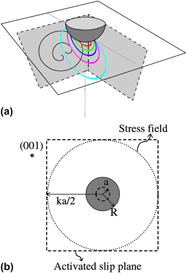Article contents
Dislocation mechanisms of radius effect on displacement bursts during spherical nanoindentations
Published online by Cambridge University Press: 12 June 2012
Abstract

Indentation load–displacement curves for Mo (100) single crystals reveal clear displacement bursts from spherical indenters with various radii from ∼0.1 to ∼130 μm. There are two different size-dependent mechanisms for dislocation evolution involved during the displacement bursts. It has been postulated that these bursts are triggered by the nucleation of dislocations for a small indenter radius and the activation of preexisting dislocations for a large indenter radius. We present a simple model with which the displacement bursts from a larger indenter radius can be rationalized. This model relates the load and the excursion length during the first displacement burst. The correspondence between the model and experimental data indicates that the displacement bursts are initiated by the activation of preexisting dislocations and the model can accurately describe the mechanism for the displacement bursts from large indenters.
- Type
- Articles
- Information
- Copyright
- Copyright © Materials Research Society 2012
References
REFERENCES
- 8
- Cited by


